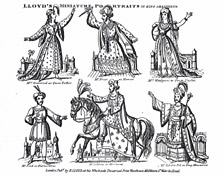This site attempts to make accessible plays written by women in the Romantic era. Site authors Crochunis and Eberle-Sinatra, both literary scholars, have collected, edited, and presented 18 plays not previously available to a broad audience. The site is directed to scholars and artists interested in exploring how electronic editing and collaboration can enhance both the scholarship and teaching of 19th-century women playwrights.
The website authors chose these plays through the purposefully eclectic method of selecting works that current scholars find compelling. Rather than focusing exclusively on plays cherished by either contemporaries or later generations, they have often included plays that flopped or were censored, recognizing that the controversies surrounding these point to intriguing historical scenarios, ranging from proto-feminism in a pre-feminist era (in, for example, Lady Eglantine Wallace’s The Ton) to discussions of radical politics in late 18th-century Britain, as in Elizabeth Inchbald’s The Massacre.
The editors include 3,000- to 6,000-word introductions to nearly every play published. These discussions provide the reader with authors’ biographies, historical information regarding the theatrical productions—including where and when they were performed (or censored)—and insights into the critical and popular receptions they initially received.
The essays also discuss both literary and historical issues relevant to the circumstances in which they were created. We learn, for instance, of the Jacobin and anti-Jacobin political context in which Elizabeth Inchbald created The Massacre in 1792. The essays also introduce the 1786 impeachment of Warren Hastings as Governor-General of India that served as a backdrop to Mariana Starke’s The Sword of Peace and as a lightning-rod of criticism over Britain’s colonial policies in the later 18th century. The introductions are aimed at academic audiences and presume some familiarity with theatre history; thus they may be helpful to instructors, but may be beyond the scope of students, particularly at the secondary level.
Besides these introductions, “Essays” contains an additional 18 scholarly papers. Some of them focus on the process of electronically editing such plays—marking up and encoding text, and presenting it online. But others, like Kate Newey’s “Women’s Theatrical Texts and Contexts,” explicitly address issues involved in teaching that instructors might find directly relevant. While an extensive bibliography is included, the sections on “Teaching,” “Books,” and “Performances” provide very limited resources. More promising are the 26 links to related sites covering the history of women writers, theater, and Romantic study resources found in “Links.”
This rich body of texts provides instructors the opportunity to engage students in the examination of history through unconventional historical sources. Teachers might create assignments in which students research the historical context of a particular play that explores then-contemporary themes. See, for example, Mariana Starke’s implicit support for British imperialism in 18th-century India in The Sword of Peace and her resonant criticism of African slavery in the same work.
Students then might consider how and why the author chose to represent these issues in her literary text in the way she did: Were her views consistent with popular conceptions of her day or decisively novel? What interpretations or distortions appeared in her representation of events? What was omitted or emphasized in her portrayal of historical events and why? Alternatively, they might read the text of a play set in a different time period from that of its author—for example, Elizabeth Polack’s Esther (a presentation of the Jewish bride of the Persian King Ahasuerus), in order to analyze how the author’s own time and concerns influenced her particular depiction of material dating from a vastly different historical context.



